Blois
Blois (/blwɑː/ BLWAH; French: [blwa] (![]() listen)) is a city and the capital of Loir-et-Cher department in Centre-Val de Loire, France,[2] situated on the banks of the lower river Loire between Orléans and Tours.
listen)) is a city and the capital of Loir-et-Cher department in Centre-Val de Loire, France,[2] situated on the banks of the lower river Loire between Orléans and Tours.
Blois | |
|---|---|
Prefecture and commune | |
 Panoramic view of Blois on the Loire River | |
 Coat of arms | |
Location of Blois 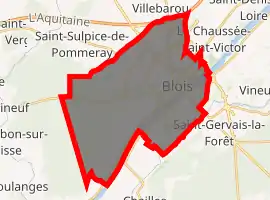
| |
 Blois 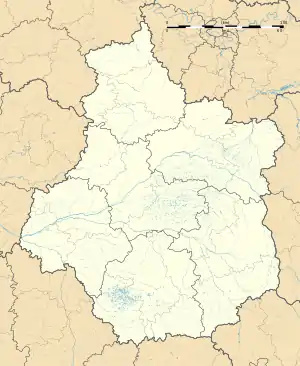 Blois | |
| Coordinates: 47°35′38″N 1°19′41″E | |
| Country | France |
| Region | Centre-Val de Loire |
| Department | Loir-et-Cher |
| Arrondissement | Blois |
| Canton | Blois-1, 2 and 3 and Vineuil |
| Intercommunality | Blois |
| Government | |
| • Mayor (2020–2026) | Marc Gricourt (PS) |
| Area 1 | 37.46 km2 (14.46 sq mi) |
| Population (2017-01-01)[1] | 46,086 |
| • Density | 1,200/km2 (3,200/sq mi) |
| Demonym(s) | Bloisian French: Blésois(e) |
| Time zone | UTC+01:00 (CET) |
| • Summer (DST) | UTC+02:00 (CEST) |
| INSEE/Postal code | 41018 /41000 |
| Elevation | 63–135 m (207–443 ft) (avg. 73 m or 240 ft) |
| 1 French Land Register data, which excludes lakes, ponds, glaciers > 1 km2 (0.386 sq mi or 247 acres) and river estuaries. | |
History
Though of ancient origin, Blois is first distinctly mentioned by Gregory of Tours in the 6th century, and the city gained some notability in the 9th century, when it became the seat of a powerful countship known as Blesum castrum.[3] In 1171, Blois was the site of a blood libel against its Jewish community that led to 31 Jews (by some accounts 40) being burned to death.[4] Their martyrdom also contributed to a prominent and durable school of poetry inspired by Christian persecution.[5] In 1196, Count Louis granted privileges to the townsmen; a commune, which survived throughout the Middle Ages, probably dated from this time. The counts of the Châtillon line resided at Blois more often than their predecessors, and the oldest parts of the château (from the thirteenth century) were built by them. In 1429, Joan of Arc made Blois her base of operations for the relief of Orléans. Joan of Arc rode the thirty-five miles on Wednesday 29 April to Blois to relieve Orléans.[6] After his captivity in England, Charles of Orléans in 1440 took up his residence in the château, where in 1462 his son, afterwards Louis XII, was born. In the 16th century Blois was often the resort of the French court. The Treaty of Blois, which temporarily halted the Italian Wars, was signed there in 1504–1505.
The city's inhabitants included many Calvinists, and in 1562 and 1567 it was the scene of struggles between them and the supporters of the Catholic Church. In 1576 and 1588 Henri III, king of France, chose Blois as the meeting-place of the States-General, and in 1588 he brought about the murders of Henry, duke of Guise, and his brother, Louis, archbishop of Reims and cardinal, in the Château, where their deaths were shortly followed by that of the queen-mother, Catherine de' Medici. From 1617 to 1619 Marie de' Medici, wife of King Henri IV, exiled from the court, lived at the château, which was soon afterwards given by King Louis XIII to his brother Gaston, Duke of Orléans, who lived there till his death in 1660.
The bishopric, seated at Blois Cathedral, dates from the end of the 17th century. In 1814 Blois was for a short time the seat of the regency of Marie Louise, wife of Napoleon I.
Blois was occupied during World War II by the German army, which took the city on 18 June 1940. The city was liberated by American soldiers during the last two weeks of August 1944. On both occasions, the city withstood several days of bombing.
Population
|
|
Tourism
Château de Blois
The Château de Blois, a Renaissance château once occupied by King Louis XII, is located in the centre of the city, and an 18th-century stone bridge spans the Loire. As Blois is built on a pair of steep hills, winding and steep pathways run through the city, culminating in long staircases at various points. To the south of the city, the Forêt de Russy is a reminder of the thick woods that once covered the area.
The house of magic
La Maison de la Magie Robert-Houdin (The House of Magician Jean Eugène Robert-Houdin) is a museum fronting on the Château. As a museum of France, it is the only public museum in Europe which incorporates in one place collections of magic and a site for permanent performing arts, and is directly reflects the personality of Robert-Houdin.[7][8][9][10]
Transport
The Gare de Blois railway station offers direct connections to Paris, Orléans, Tours, Nantes and several regional destinations. The A10 motorway connects Blois with Paris, Orléans and Tours.
Personalities
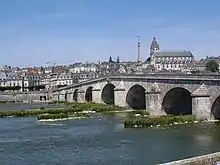
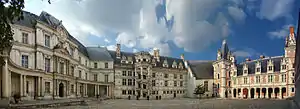
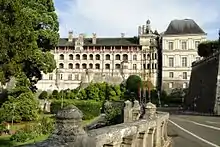
Blois was the birthplace of:
- Thubois (c.1044–1090)
- Stephen (c. 1096–1154), King of England from 1135 to 1154.
- Louis XII (1462–1515), King of France from 1498 to 1515
- Jean Morin (1591–1659), theologian and biblical scholar of Protestant parents
- Denis Papin (1647 – c. 1712), physicist, mathematician and inventor
- Thomas de Mahy, Marquis de Favras (1744–1790), royalist
- Jean Marie Pardessus (1772–1853), lawyer
- Jacques Nicolas Augustin Thierry (1795–1856), historian
- Jean Eugène Robert-Houdin (1805–1871), magician
- René Guénon (also Sheikh 'Abd al-Wahid Yahya), (1886–1951), author, philosopher, social critic, the founder of the Traditionalist School
- Philippe Ariès (1914–1984), medievalist and historian
- Albert Ronsin (1928–2007), 20th-century French scholar, historian, librarian, and curator
- Philippe Gondet (1942-2018), footballer
- Claudine Doury (born 1959), photographer
- Sonia Bompastor (born 1980), female footballer
- Aly Cissokho (born 1987), footballer of Senegalese descent
- Bernard Onanga Itoua footballer
- Nicolas Vogondy (born 1977), cyclist
- Corentin Jean (born 1995), footballer
- Fabrice Moireau (born 1962), 21st-century French watercolourist and artist
- Alexis Khazzaka (born 1994), Lebanese footballer[11]
International relations
Blois is twinned with:
 Waldshut-Tiengen, Germany, since 30 June 1963
Waldshut-Tiengen, Germany, since 30 June 1963 Weimar, Germany, since 18 February 1995
Weimar, Germany, since 18 February 1995 Lewes, United kingdom, since 30 June 1963[12]
Lewes, United kingdom, since 30 June 1963[12] Sighişoara, Romania, since 18 November 1995
Sighişoara, Romania, since 18 November 1995 Urbino, Italy, since 1 May 2003 ("friendship protocol")
Urbino, Italy, since 1 May 2003 ("friendship protocol") Huế, Vietnam, since 23 May 2007
Huế, Vietnam, since 23 May 2007
Fictional references
Athos, the count of La Fère (from Alexandre Dumas' The Three Musketeers) has a castle in Blois, in Twenty Years After, and The Vicomte de Bragelonne (from the same author).
References
- "Populations légales 2017". INSEE. Retrieved 6 January 2020.
- "Blois | Loire Valley | France". www.experienceloire.com. Retrieved 5 August 2017.
- "The Chateau de Blois & St Nicholas Cathedral, Blois from the River Loire | Artware Fine Art". www.artwarefineart.com. Retrieved 5 August 2017.
- The Martyrs of Blois
- JEWISH POETRY Jewish Poetry And Martyrdom in Medieval France. Susan L. Einbinder. Princeton University Press. 2002.
- Smith, John, Holland (1973). "Joan of Arc." New York: Charles Scribner's Sons
- Blois, La Maison de la Magie at virtourist.com
- "Mussee de la Magie". Archived from the original on 18 July 2011.
- "Travel signposts, Paris Museum of Magic". Archived from the original on 2 March 2011.
- "Keck, Gayle, Washington Post, And Now for Paris' Next Trick". The Washington Post. 12 June 2005. Retrieved 23 April 2010.
- "Alexis Khazzaka - Soccer player profile & career statistics - Global Sports Archive". globalsportsarchive.com. Retrieved 21 August 2020.
- "British towns twinned with French towns [via WaybackMachine.com]". Archant Community Media Ltd. Archived from the original on 5 July 2013. Retrieved 20 July 2013.
External links
| Wikimedia Commons has media related to Blois. |
- Official website
- Documentary photography of Blois by "Sayf"
- Jewish Encyclopedia entry
- INSEE commune file